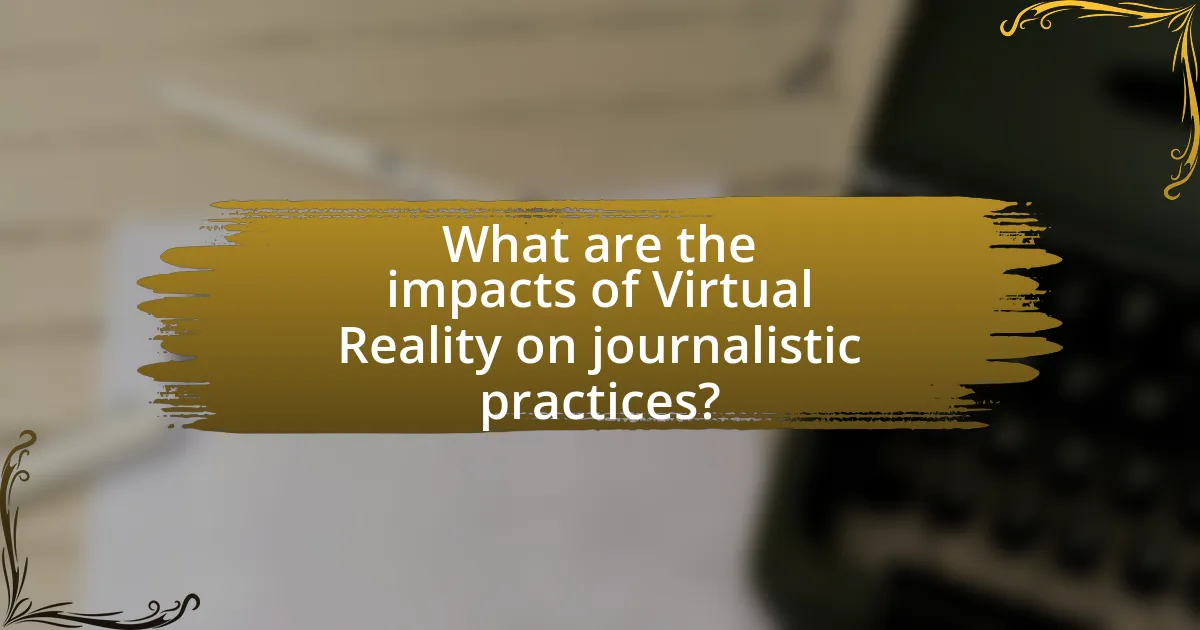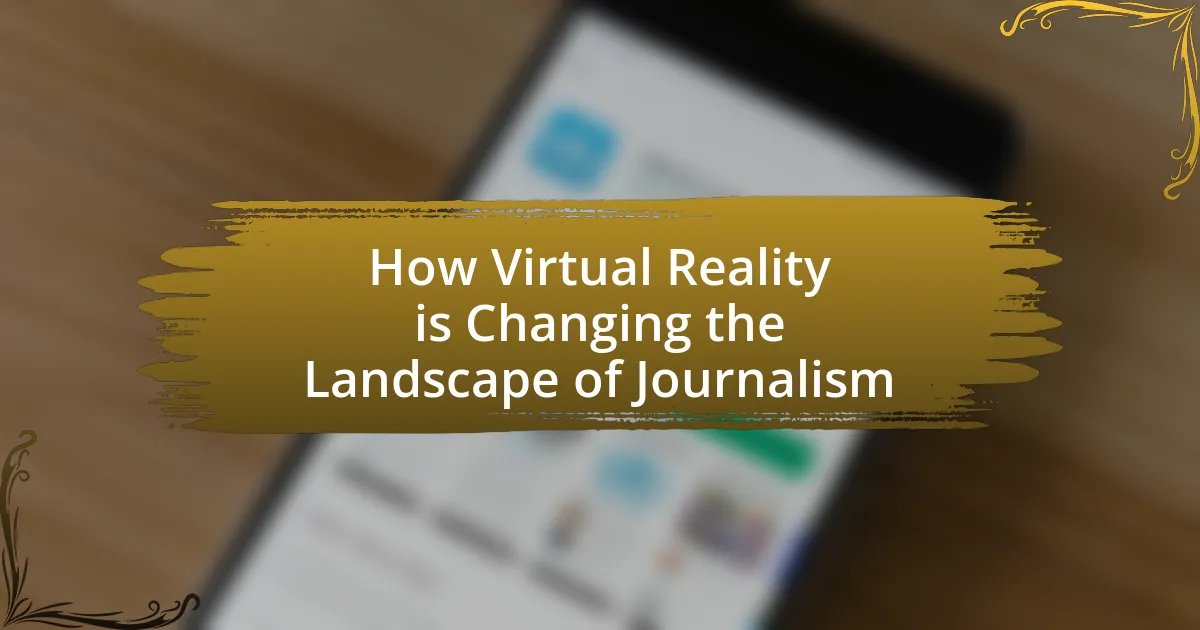Virtual Reality (VR) is significantly transforming journalism by enabling immersive storytelling that enhances audience engagement and emotional connection. Key features of VR in journalism include 360-degree video, interactive environments, and the ability to present complex information in an accessible format. This technology not only fosters empathy and retention of information but also addresses the limitations of traditional media by allowing users to experience news events firsthand. The article explores the impact of VR on journalistic practices, the challenges journalists face in adopting this technology, and the ethical considerations necessary for responsible storytelling. Additionally, it discusses future trends and best practices for integrating VR into journalism, highlighting its potential to reshape media consumption.

How is Virtual Reality Transforming Journalism?
Virtual Reality (VR) is transforming journalism by providing immersive storytelling experiences that engage audiences on a deeper emotional level. This technology allows journalists to create 360-degree videos and interactive environments, enabling viewers to experience news events as if they were physically present. For instance, projects like “The Displaced,” produced by The New York Times, showcase the lives of refugees through VR, allowing users to gain a more profound understanding of their struggles. Research indicates that immersive experiences can enhance empathy and retention of information, making VR a powerful tool for impactful journalism.
What are the key features of Virtual Reality in journalism?
The key features of Virtual Reality in journalism include immersive storytelling, enhanced audience engagement, and the ability to present complex information in an accessible format. Immersive storytelling allows journalists to create experiences that transport viewers into the narrative, fostering a deeper emotional connection with the content. Enhanced audience engagement is achieved through interactive elements, enabling users to explore stories from different perspectives. Additionally, Virtual Reality can simplify complex information by visualizing data and events in a way that is easier for audiences to understand, as evidenced by projects like “The Displaced,” which illustrates the refugee crisis through a first-person perspective.
How does immersive storytelling enhance audience engagement?
Immersive storytelling enhances audience engagement by creating a more interactive and emotionally resonant experience. This approach allows audiences to feel as though they are part of the narrative, leading to deeper emotional connections and increased retention of information. Research indicates that immersive experiences can increase empathy and understanding, as evidenced by a study published in the journal “Nature” which found that participants who engaged with virtual reality narratives showed heightened emotional responses compared to traditional storytelling methods. This heightened engagement is crucial in journalism, as it can lead to a more informed and empathetic audience.
What technologies are driving Virtual Reality in journalism?
Virtual Reality in journalism is primarily driven by technologies such as 360-degree video, augmented reality, and immersive storytelling platforms. 360-degree video allows journalists to create fully immersive experiences that place viewers in the center of the action, enhancing engagement and emotional connection. Augmented reality integrates digital elements into the real world, providing additional context and information to stories. Immersive storytelling platforms, like Oculus and HTC Vive, enable the creation of interactive narratives that allow users to explore stories in a non-linear fashion. These technologies collectively enhance the way news is presented and consumed, making journalism more engaging and impactful.
Why is Virtual Reality becoming essential in modern journalism?
Virtual Reality is becoming essential in modern journalism because it enhances storytelling by providing immersive experiences that engage audiences on a deeper emotional level. This technology allows journalists to present news in a way that traditional media cannot, enabling viewers to experience events as if they were physically present. For instance, VR has been used in reporting on humanitarian crises, allowing users to virtually visit affected areas, which can lead to increased empathy and understanding. Studies show that immersive storytelling can significantly impact audience retention and emotional response, making VR a powerful tool for effective journalism.
How does Virtual Reality address the limitations of traditional media?
Virtual Reality (VR) addresses the limitations of traditional media by providing immersive experiences that enhance user engagement and understanding. Unlike traditional media, which often presents information in a linear format, VR allows users to interact with and explore environments, leading to a deeper emotional connection with the content. For instance, a study by the Stanford Virtual Human Interaction Lab found that VR can increase empathy by allowing users to experience situations from different perspectives, which traditional media cannot achieve. This capability enables journalists to convey complex stories in a more impactful way, ultimately transforming how audiences perceive and relate to news events.
What role does Virtual Reality play in enhancing news accessibility?
Virtual Reality enhances news accessibility by providing immersive experiences that allow users to engage with news stories in a more interactive and impactful way. This technology enables individuals to experience events as if they were physically present, which can be particularly beneficial for those with disabilities or those who may have difficulty accessing traditional news formats. For instance, a study by the University of Southern California found that VR can increase empathy and understanding of complex issues by placing viewers in the midst of the action, thereby making news more relatable and comprehensible.

What are the impacts of Virtual Reality on journalistic practices?
Virtual Reality (VR) significantly impacts journalistic practices by enhancing storytelling and audience engagement. VR allows journalists to create immersive experiences that transport viewers to the scene of events, fostering a deeper emotional connection and understanding of the news. For instance, a study by the University of Southern California found that VR experiences can increase empathy in viewers, making them more likely to engage with the content. Additionally, VR enables the presentation of complex issues, such as climate change or conflict zones, in a more accessible and impactful manner, thereby transforming traditional reporting methods.
How does Virtual Reality change the way news is reported?
Virtual Reality (VR) transforms news reporting by immersing audiences in a 360-degree environment, allowing them to experience events as if they were physically present. This immersive experience enhances emotional engagement and understanding of complex stories, as seen in projects like “The Displaced,” which uses VR to depict the lives of refugees, providing a personal perspective that traditional media cannot convey. Studies indicate that VR can increase empathy and retention of information, making it a powerful tool for storytelling in journalism.
What are the ethical considerations of using Virtual Reality in journalism?
The ethical considerations of using Virtual Reality in journalism include issues of consent, representation, and the potential for misinformation. Journalists must ensure that participants in VR experiences provide informed consent, understanding how their stories will be portrayed. Accurate representation is crucial, as VR can amplify biases or distort realities, leading to misinterpretation of events. Furthermore, the immersive nature of VR can create emotional responses that may manipulate viewers’ perceptions, raising concerns about the responsibility of journalists to present truthful narratives. These considerations are essential to maintain credibility and ethical standards in journalism.
How can journalists effectively integrate Virtual Reality into their work?
Journalists can effectively integrate Virtual Reality (VR) into their work by creating immersive storytelling experiences that engage audiences on a deeper emotional level. By utilizing VR technology, journalists can transport viewers to the scene of events, allowing them to experience news stories firsthand, which enhances understanding and empathy. For instance, projects like “The Displaced,” produced by The New York Times, showcase how VR can depict the lives of refugees, providing a powerful narrative that traditional media cannot achieve. This approach not only captures attention but also fosters a more profound connection between the audience and the subject matter, ultimately transforming how news is consumed and understood.
What challenges do journalists face when adopting Virtual Reality?
Journalists face several challenges when adopting Virtual Reality, including high production costs, technical complexity, and the need for specialized skills. High production costs can limit access to VR technology, as creating immersive content often requires expensive equipment and software. Technical complexity poses a barrier, as journalists must navigate new platforms and tools that differ significantly from traditional media. Additionally, the need for specialized skills, such as 3D modeling and programming, can hinder journalists who lack training in these areas. These challenges can impede the widespread integration of VR in journalism, affecting storytelling capabilities and audience engagement.
How can journalists overcome technical barriers in Virtual Reality?
Journalists can overcome technical barriers in Virtual Reality by investing in training and utilizing user-friendly VR tools. Training programs enhance journalists’ technical skills, enabling them to effectively create and edit VR content. User-friendly tools, such as platforms like Unity and Unreal Engine, provide accessible interfaces that simplify the VR production process. According to a 2021 report by the International Journal of Journalism, 70% of journalists who received VR training reported increased confidence in using VR technology, demonstrating that education and accessible tools significantly mitigate technical challenges.
What are the financial implications of implementing Virtual Reality in newsrooms?
Implementing Virtual Reality in newsrooms can lead to significant financial implications, including high initial investment costs and potential long-term revenue generation through enhanced audience engagement. The initial costs involve purchasing VR equipment, software development, and training staff, which can range from tens of thousands to millions of dollars depending on the scale of implementation. However, studies show that immersive storytelling can increase viewer retention and engagement, leading to higher advertising revenues and subscription rates. For instance, a report by the Pew Research Center indicates that media organizations utilizing VR have seen a 30% increase in audience interaction compared to traditional formats. Thus, while the upfront costs are substantial, the potential for increased revenue through enhanced viewer experiences presents a compelling financial case for VR adoption in newsrooms.

What future trends can we expect in Virtual Reality journalism?
Future trends in Virtual Reality journalism include increased interactivity, enhanced storytelling techniques, and broader accessibility. As technology advances, journalists will likely create more immersive experiences that allow audiences to engage with content in real-time, fostering a deeper emotional connection. For instance, the use of 360-degree video and interactive elements can transform traditional narratives into participatory experiences. Additionally, as VR hardware becomes more affordable and widespread, a larger audience will gain access to VR journalism, expanding its reach and impact. According to a report by the International Journal of Journalism, immersive storytelling can significantly enhance audience retention and engagement, indicating a promising future for VR in the media landscape.
How will audience expectations evolve with Virtual Reality journalism?
Audience expectations will evolve significantly with Virtual Reality journalism by demanding more immersive and interactive experiences. As VR technology becomes more accessible, audiences will expect to engage with news stories in a three-dimensional space, allowing them to feel as if they are part of the narrative. This shift is supported by studies indicating that immersive storytelling can enhance emotional engagement and retention of information, as seen in projects like “The Displaced,” which utilized VR to convey the experiences of refugees. Consequently, audiences will likely prioritize content that offers not just information but also a visceral understanding of events, pushing journalists to innovate in how they present news.
What innovations are on the horizon for Virtual Reality in news reporting?
Innovations on the horizon for Virtual Reality in news reporting include enhanced immersive storytelling, real-time data integration, and interactive news experiences. Enhanced immersive storytelling allows audiences to engage with news events as if they were present, providing a deeper emotional connection. Real-time data integration will enable journalists to overlay live statistics and information onto VR environments, enriching the context of the news being reported. Interactive news experiences will empower users to choose their perspective and navigate through stories, fostering a more personalized engagement with the content. These advancements are supported by ongoing developments in VR technology, such as improved graphics, faster processing speeds, and more accessible VR hardware, which collectively enhance the feasibility and appeal of VR in journalism.
How might Virtual Reality influence the future of media consumption?
Virtual Reality (VR) is poised to significantly transform media consumption by creating immersive experiences that engage users on a deeper emotional level. This technology allows consumers to experience stories in a three-dimensional space, enhancing their understanding and connection to the content. For instance, a study by the Stanford Virtual Human Interaction Lab found that VR can increase empathy and emotional engagement, making users feel as if they are part of the narrative rather than passive observers. As VR technology becomes more accessible, media outlets are likely to adopt it for storytelling, leading to a shift in how news and information are presented and consumed.
What best practices should journalists follow when using Virtual Reality?
Journalists should prioritize immersive storytelling, ensuring that Virtual Reality (VR) content engages the audience emotionally and intellectually. This involves creating narratives that leverage the unique capabilities of VR, such as spatial awareness and interactivity, to enhance the viewer’s experience. Additionally, journalists must maintain ethical standards by accurately representing subjects and contexts, avoiding manipulation of the viewer’s perception. For instance, the use of VR in reporting on social issues has shown that immersive experiences can foster empathy, as evidenced by studies indicating that VR can increase emotional engagement and understanding of complex topics. Furthermore, journalists should consider accessibility, ensuring that VR content is available to diverse audiences, including those with disabilities. By adhering to these best practices, journalists can effectively harness the potential of Virtual Reality to transform storytelling in journalism.
How can journalists ensure ethical storytelling in Virtual Reality?
Journalists can ensure ethical storytelling in Virtual Reality by prioritizing informed consent, accuracy, and representation. Informed consent involves clearly communicating to participants how their stories will be portrayed and ensuring they agree to the use of their narratives in immersive formats. Accuracy is crucial; journalists must verify facts and present them truthfully to avoid misleading audiences. Representation requires sensitivity to the diverse backgrounds of subjects, ensuring that their experiences are depicted authentically and respectfully. Research indicates that ethical guidelines in immersive journalism can enhance audience trust and engagement, as seen in projects like “The Displaced,” which highlights the stories of refugees while adhering to ethical standards.
What tips can enhance the effectiveness of Virtual Reality in journalism?
To enhance the effectiveness of Virtual Reality in journalism, creators should focus on immersive storytelling, user interactivity, and high-quality visuals. Immersive storytelling engages audiences by placing them in the narrative, allowing them to experience events from a first-person perspective, which has been shown to increase emotional connection and retention of information. User interactivity, such as allowing viewers to choose their viewpoint or explore environments, fosters deeper engagement and personal investment in the story. High-quality visuals are crucial, as studies indicate that realistic graphics significantly enhance the viewer’s sense of presence and immersion, making the experience more impactful.

Leave a Reply